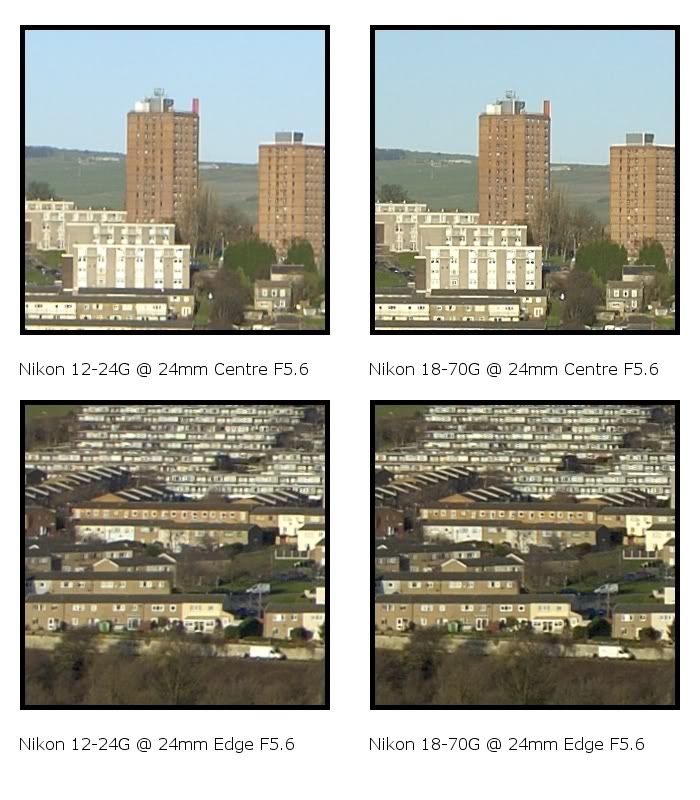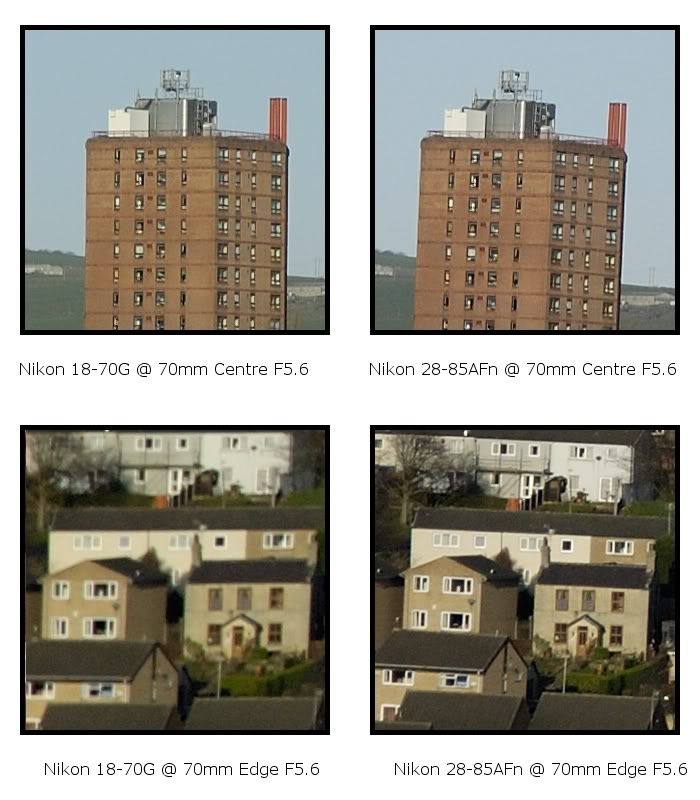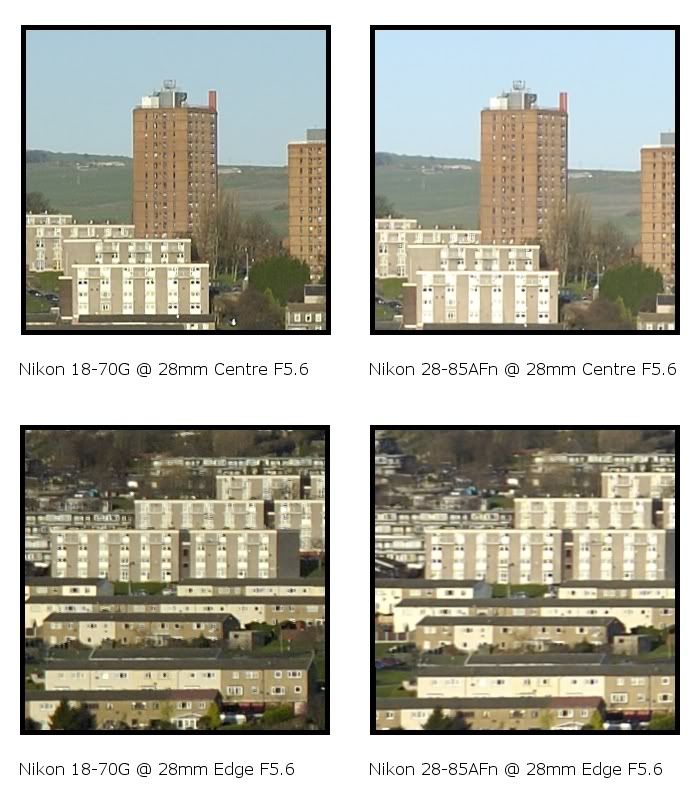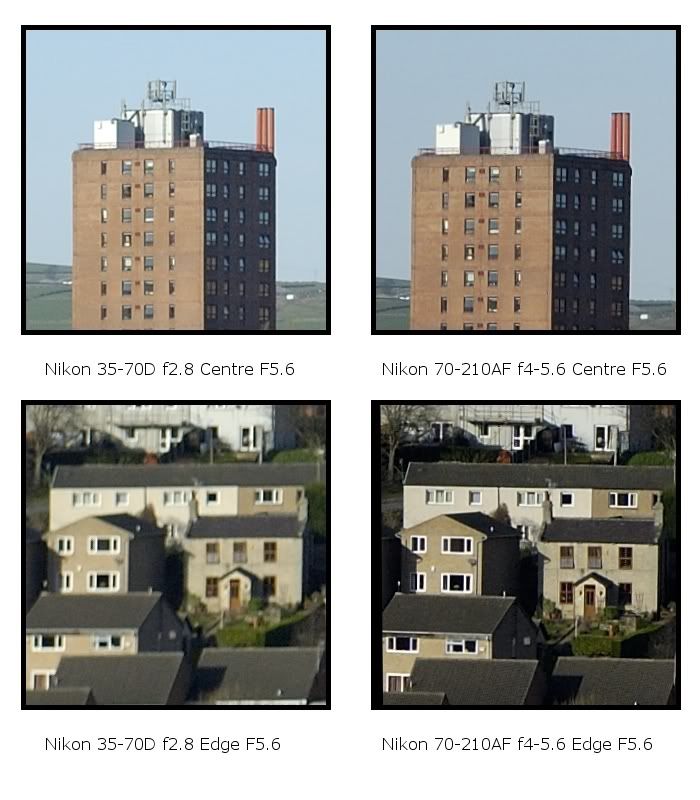I've read a lot of comments which say a 6MP camera cannot match the resolution of film and therefore lens quality need not be as high. Over the last two and a half years of using a Nikon D-70 I would have to disagree with that. Not only is a good 6MP camera the equal of film, you
can see marked differences in lens quality. With that in mind I decided to run some tests on a few of my lenses (all Nikon): the 12-24mm f4 G, the 18-70 f3.5-4.5 G, the 28-85mm f3.5-4.5 AFn, the 35-70 f2.8 D and the 70-210 f4-5.6 AF.
For the purposes of this test I used my Nikon D-70 on ISO 200 and set to F5.6. The crops are 300x300 pixels at a ratio of 1:1, taken from the centre and left edge/left bottom corner - the full sized images which these are taken from are 3008x2000 pixels. The cameras AF was used for all the photos, centered on the tower block. The only post camera processing was via PTlens to eliminate chromatic aberration, distortion and vignetting. The photos have not been sharpened. The reason for choosing f5.6 as the aperture is because it is easier for lenses to perform better stopped down, so at f11 most lenses look pretty good - f5.6 is a little more challenging - as we shall see...
Wide angle: 12-24 v 18-70


Only minor differences between these two lenses at these focal lengths. The 18-70 does display a slightly warm tone, consistent throughout these tests.
Medium wide to Telephoto: 18-70 v 28-85


Six of one and half a dozen of the other. The 18-70 is slightly better at 28mm, with the 28-85 suffering a little chromatic aberration (removed with PTlens) and a little soft at the edges (gone at f11). The edge of the 18-70 at 70mm is notably poorer than the 28-85 - again this is gone by f11.
Telephoto: 18-70 v 28-85 v 35-70 v 70-210 at 70mm


Though a different test to the previous 18-70 v 28-85, these two lenses produced similar test results. But hold on to your socks: look at the edge performance of the 70-210 - WOW! It goes right into the D-70's resolution limit, the only lens here to do that. This is the lens Ken Rockwell raves about
WWW Link and with good reason.
And now for the bad news... the lens most professional photographers have in their kit bag, and supposedly the sharpest zoom ever made, the Nikon 35-70 f2.8. Throughout its zoom range and aperture range, this lens is consistently less sharp than any other lens here - disappointing. Whether I have a bad lens or not I don't know, but it doesn't deserve it's cult status and does not travel in my kit bag.
A summary then:
12-24: Excellent performer at all settings. Of particular note is its resistance to flare; even with the sun in the picture there is none of note - nice one Nikon! Whether or not all this justifies its £700 price tag only you can decide. I bought one and I'm delighted with it.
18-70: Surely the best kit lens ever. Can be bought seperately at £200, mine came fitted to my D-70. Suffers from strong distortion at the focal length extremes and produces significant vignetting at wider apertures - both easily correctable with PTlens. Very sharp for this type of lens.
28-85: One of my older lenses now only available second hand. My most consistant performer despite a little softness at 28mm. From 35mm to 85mm I can confidently use this lens wide open. Build quality is classic Nikon - rock solid. None of that plastic nonsense here...
35-70: Bleh - disappointing. Seems unable to produce sharp images at any setting.
70-210: Another older lens available second hand only. Performance from 70mm to 135mm is nothing short of staggering for such a small, lightweight and inexpensive lens. Sharpness starts to drop off towards 210mm, but it's still pretty good.
Finally, it must be said all of the lenses tested here will produce sharp A4 prints, this test is purely me being critical. If at the end of the day you are satisfied with the quality of your photos (as I am), then tests don't really matter. Apart from the 35-70 f2.8 which is going for sale, these lenses will be staying with me for many years to come.